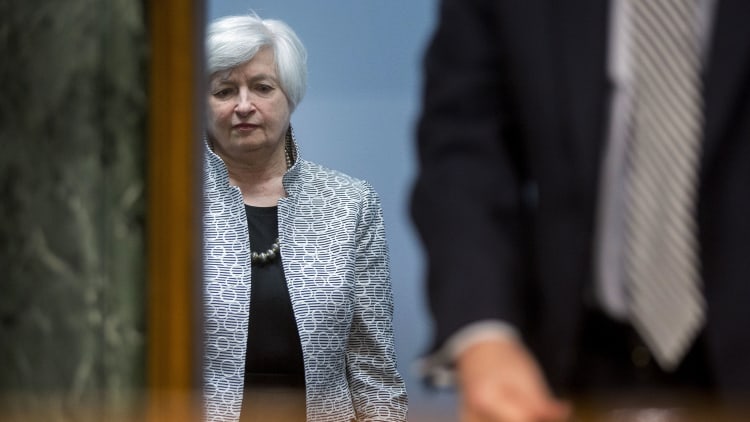
The U.S. economy created 209,000 jobs in July, below expectations, as the unemployment rate climbed to 6.2 percent, reflecting a consistent but unspectacular level of employment growth.
Economists expected nonfarm payroll growth to hit 233,000 in the month, down from an upwardly revised 298,000 in June, and unemployment to fall to 6.0 percent from 6.1 percent. An alternative measure of unemployment which includes the discouraged and those working part-time for economic reasons—the underemployed—rose slightly to 12.2 percent.
Read MoreChart: What's the real unemployment rate?
Traders liked the unemployment data a bit, perhaps intuiting that it would keep the Federal Reserve on hold with its ultra-easy monetary policy. Stock futures had been under selling pressure earlier after Thursday's aggressive selloff, but the market opened flat to mixed.
"That stocks should rise on the relief of a weaker than expected reading, possibly because it is a bond friendly report, suggests investors are clutching at the safety net of easier for longer Fed policy," said Andrew Wilkinson, chief market analyst at Interactive Brokers. "However, the basis of Thursday's worst day of the year was probably less centered on falling bond prices and had more to do with geopolitics and global equity price weakness. It all seems rather odd that stock futures have just about eliminated a double-digit slide ahead of the number."
Market experts said the numbers were right around the sweet spot that reflected economic growth that was solid but not strong enough to change the central bank's approach.
"It is calming fears of more aggressive hawkish Fed behavior," said Lawrence Creatura, portfolio manager at Federated Investors. "'Goldilocks' is a cliche that's been beaten to death, however, the cliche fits and this is a data point which supports the not-too-hot not-too-cold pattern of economic data."
Reversing what happened in June, most of the job creation came from full-time positions, which rose 285,000, while part-time jobs also climbed, by 52,000.
Inflationary pressures also were absent from the Bureau of Labor Statistics report, with wages rising just 1 cent to $24.,45, while the average hours worked was flat at 34.5 hours.
The job creation total was spot-on with the average of the past year, with the bulk of new positions added in professional and businesses services, which grew by 47,000. Manufacturing added 28,000, retail rose 27,000 and construction increased by 22,000.
"The trend in employment growth, which supported stellar second quarter GDP growth and strong consumer and business confidence, is holding up for now," said Gad Levanon, director of macroeconomic and labor market research at The Conference Board.
Read MoreThis firm helps others by growing its own workforce
Markets had been watching the number to see how it might influence monetary policy. The Fed has been unwinding its monthly bond-buying program but has kept short-term interest rates near zero as central bank officials believe considerable slack remains in the labor market.
Drops in the unemployment rate had been a combination of trend-level job creation and labor force participation at the lowest level in about 35 years, a rate that edged higher in July to 62.9 percent.
Inside the data, the unemployment rate for white women rose from 5.3 percent to 5.7 percent, while the rate for blacks jumped from 10.7 percent in June to 11.4 percent in July, though that is well below the 12.6 percent from a year ago. The ranks of the long-term unemployed (more than 27 weeks) rose 74,000, while short-term unemployment of less than five weeks jumped by 177,000. Average weeks unemployed dropped considerably, though, falling from 33.5 to 32.4.
The jobs market remains a mixed bag, in which wages have remained relatively flat and skilled labor has been harder to come by, according to job placement experts.
However, Procter & Gamble CEO Jon Moeller said demand has been brisk for job openings at the company, which has slashed its workforce by 16 percent over the past two years.
"We're in maybe a little bit of a privileged position," he said. "We have almost a million applications a year for about 3,000 jobs. So we continue to hire very qualified candidates across the board and are pleased with the quality of talent we're able to attract."
In addition to the June revision, May's number rose to 229,000 from 224,000.
In other economic news, consumer spending rose for a fifth consecutive month in June, climbing 0.4 percent, in line with forecasts. Adjusted for inflation, it rose 0.2 percent after increasing 0.1 percent in May. Spending increased 2.5 percent in the second quarter, according to Wednesday's report on gross domestic product.
Despite the gains in spending, inflation retreated in June.
A price index for consumer spending rose 0.2 percent after advancing 0.3 percent in May. In the 12 months through June, the personal consumption expenditures price index rose 1.6 percent. It had increased 1.7 percent in May.
Excluding food and energy, prices edged up 0.1 percent after gaining 0.2 percent the prior month. The so-called core PCE price index is the Federal Reserve's preferred inflation measure.
It increased 1.5 percent from a year ago, still below the Fed's 2 percent target, after rising by the same margin in May.
—By CNBC's Jeff Cox.
—Reuters contributed to this report.
CORRECTION: This article has been corrected to show 209,000 jobs were created in July.


